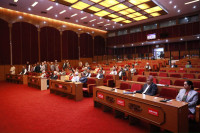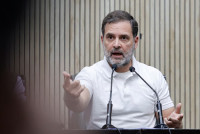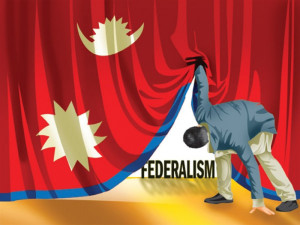Columns
Sit down and talk
Nepal and India should come together and hold negotiations to resolve their border issues..jpg&w=900&height=601)
Gyan Chandra Acharya
Nepal-India relations have taken a downturn in the last few weeks due to differences over border issues. The row was sparked by the inauguration of a road connecting the Indian town of Dharchula with Kailash, Tibet through Lipulekh which Nepal claims encroaches upon Nepali territory. The government of Nepal unveiled a new map showing the area in question up to Limpiyadhura within the country's borders. India rejected the map as an unjustified cartographic assertion.
Joint technical teams consisting of Nepali and Indian officials had worked from 1981 to 2007 to complete the delineation of the India-Nepal border. They drew 182 strip maps and initialled them except for those of Kalapani and Susta due to differences over their position. There are many other border areas where changing river courses, settlement on no man's land and lost boundary pillars make demarcation of the border a complex task, but there is no difference of opinion over the actual location of the boundary.
During Indian Prime Minister Modi’s visit to Nepal in April 2014, a joint press release was issued underlining the need to resolve pending Nepal-India boundary issues. It also welcomed the joint commission's decision to direct the respective foreign secretaries to work on outstanding boundary issues including Kalapani and Susta. The joint commission had recommended holding talks at the foreign secretary-level to sort things out based on historical facts and evidence.
Nepal has consistently said that the 1816 Sugauli Treaty should be the basis for delineating the border. Article 5 of the treaty clearly spells out where the frontier is located. Agreeing on the main source of the Kali River and looking at historical facts and evidence should contribute to resolving the differences. Hydrological experts, cartographers and international norms and practices should be able to guide the two sides in finding a solution.
Border issues are a very important and sensitive matter to any nation as a physical expression of its sovereignty. But it is also true that there is hardly any region in the world where we do not find contestation on border issues. South Asia is no exception. Therefore, managing border disputes and resolving them through dialogue based on historical facts and evidence as per relevant international laws, norms and practices should be our collective commitment and endeavour.
Considering the age-old ties, multidimensional linkages and friendly relationships existing between the two countries and peoples, it is only natural that they sit down and start negotiations with a view to resolve their differences. There is no other way. Inordinate delays in starting bilateral talks will only inflame passions on both sides, which is not in the interest of either country. Intense public discourse on such an important issue is unavoidable, but it is the duty of the political and diplomatic leadership to ensure that they seize the moment, keep the direction positive, and focus on strengthening understanding with dialogue and cooperation.
On May 28, India's Ministry of External Affairs issued a statement expressing its openness to engaging with all its neighbours in an environment of trust and confidence which is a positive signal. Now, this needs to be followed through with actual dialogue. The following should be considered to keep bilateral relations on an even keel.
First, clear political-level dialogue and communication should be held between the leadership of the two countries to create and sustain a conducive atmosphere for holding fruitful discussions on the border issue. They should agree to give their respective foreign secretaries the necessary instructions to immediately start a dialogue with the view of resolving the differences, as agreed by the Nepali and Indian prime ministers in April 2014.
Second, a date should be fixed for the two foreign secretaries to meet and discuss the issues in order to put forth substantive views and facts and evidence pertaining to the outstanding border issues before each other. Third, the two sides should agree not to change the status quo until the issues are resolved amicably. This is part of peremptory norms when we have claims and counterclaims regarding the border issues.
Fourth, each side should have their technical teams provide them with technical support as to the cartographic, historical and other legal issues involved in ascertaining the claims. Fifth, priority should be given to consistent and regular discussions on these issues by both sides so that there will be no unnecessarily prolonged hiatus between the meetings. Prioritisation and continuous efforts are needed by both sides to find an amicable solution to such an important issue.
India and Bangladesh have signed two border agreements on their land and maritime borders after regular negotiations lasting almost three decades. India and Sri Lanka similarly resolved their border issues following decades of negotiations. With the new urgency and benefit of new technologies, Nepal and India should be able to resolve their differences in a relatively short period of time. But we must begin to have a focused hearing of each other’s views on claims, evidence and historical facts.
Nepal and India should continue to work for consolidating their bilateral relationship, which should benefit both the countries equitably. There is much more to be gained by both sides by deepening and widening collaboration in various fields of mutual interest. Let us start talking to resolve the differences over border issues and focus on promoting bilateral relations with a view to taking it to a new height with full-fledged cooperation in all mutually beneficial areas.
New times and new challenges of Covid-19 demand a broad perspective from the leadership of both countries. Holding a long-term view and a forward-looking approach is critical to consolidating cooperation, trust and confidence between the two friendly neighbouring countries.
***
What do you think?
Dear reader, we’d like to hear from you. We regularly publish letters to the editor on contemporary issues or direct responses to something the Post has recently published. Please send your letters to [email protected] with "Letter to the Editor" in the subject line. Please include your name, location, and a contact address so one of our editors can reach out to you.




 19.12°C Kathmandu
19.12°C Kathmandu















